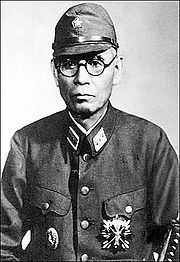Native name 岡村 寧次 Years of service 1905 - 1945 Name Yasuji Okamura | Rank General | |
 | ||
Born 15 May 1884Tokyo, Japan ( 1884-05-15 ) Commands held China Expeditionary ArmyNorthern China Area ArmyEleventh Army2nd Division Battles/wars Russo-Japanese WarSecond Sino-Japanese War Similar People Xue Yue, Seishiro Itagaki, Chiang Kai‑shek, Hideki Tojo, Iwane Matsui | ||
Yasuji Okamura (岡村 寧次, Okamura Yasuji, 15 May 1884 – 2 September 1966) was a general of the Imperial Japanese Army, war criminal, and commander-in-chief of the China Expeditionary Army from November 1944 to the end of World War II.
Contents
Early life
Born in Tokyo in 1884, Okamura enrolled in Sakamachi Elementary School and graduated eight years later. In 1897, he entered Waseda Junior High School. In 1898, he was transferred to Tokyo Junior Army School, and was transferred to Army Central Junior School later. Okamura entered the 16th class of the Imperial Japanese Army Academy in 1899 and graduated in 1904. His classmates included the future generals Itagaki Seishiro, Kenji Doihara and Ando Rikichi. He was commissioned a lieutenant in the IJA 1st Infantry Regiment.
In 1910, Okamura entered the 25th class of the Army War College, and was promoted to captain soon after graduation in 1913. He served in a number of staff positions on the Imperial Japanese Army General Staff during and after World War I. He moved briefly to China in the early 1920s, and served as a military advisor to a Chinese warlord.
From 1932 to 1933, Okamura was Vice chief-of-staff of the Shanghai Expeditionary Army under the aegis of the Kwantung Army. According to Okamura's own memoirs, he played a role in the recruitment of comfort women from Nagasaki prefecture to serve in military brothels in Shanghai. He also served as military attache to Manchukuo from 1933-1934.
Okamura was promoted to lieutenant general in 1936, and assigned command of the IJA 2nd Division.
Second Sino-Japanese War
In 1938, a year after the Marco Polo Bridge Incident, Okamura was assigned as the commander in chief of the Japanese Eleventh Army, which participated in numerous major engagements in the Second Sino-Japanese War, notably the Battles of Wuhan, Nanchang and Changsha. According to historians Yoshiaki Yoshimi and Seiya Matsuno, Okamura was authorized by Emperor Showa to use chemical weapons during those battles.
In April 1940, Okamura was promoted to the rank of full general. In July 1941, he was appointed the commander-in-chief of the Northern China Area Army. In December 1941, Okamura received Imperial General Headquarters Order Number 575 authorizing the implementation of the Three Alls Policy in north China, aimed primarily at breaking the Chinese Red Army. According to historian Mitsuyoshi Himeta, the scorched earth campaign was responsible for the deaths of "more than 2.7 million" Chinese civilians.
In 1944, Okamura was overall commander of the massive and largely successful Operation Ichigo against airfields in southern China, while retaining personal command of the Japanese Sixth Area Army. A few months later, he was appointed the commander-in-chief of the China Expeditionary Army. As late as January 1945, Okamura was still confident of the victory of Japan in China.
With the surrender of Japan on 15 August 1945, Okamura represented the Imperial Japanese Army in the China Burma India Theater official surrender ceremony held at Nanjing on 9 September 1945.
General Okamura is the first confirmed officer in the Japanese army who instituted forced prostitution. Widely known as the system of "comfort women". His order can be traced back to 1932 with documentation of Japanese Lieutenant-General Okamura Yasuji’s proposal for a “shipment” of comfort women to be sent to Shanghai. [1]
War crimes and post-war life
After the war, Okamura was convicted for war crimes in July 1948 by the Nanjing War Crimes Tribunal but was immediately protected by the personal order of Nationalist leader Chiang Kai-shek, who retained him as a military adviser for the Nationalist Government (China).
While he was questioned by the investigators, he testified about the Nanking massacre:
"I surmised the following based on what I heard from Staff Officer Miyazaki, CCAA Special Service Department Chief Harada and Hangzhou Special Service Department Chief Hagiwara a day or two after I arrived in Shanghai. First, it is true that tens of thousands of acts of violence, such as looting and rape, took place against civilians during the assault on Nanking. Second, front-line troops indulged in the evil practice of executing POWs on the pretext of (lacking) rations."
Okamura returned to Japan in 1949 and died in 1966.
